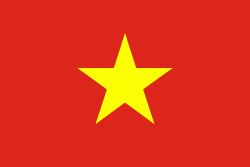Bac Ninh province (Tỉnh Bắc Ninh)
The province is rich in culture and is known nationally for Quan họ folk music. Quan họ was recognized as an Intangible Cultural Heritage by the UNESCO in 2009.
Bắc Ninh has a Human Development Index of 0.768 (high), ranking seventh among all municipalities and provinces of Vietnam.
During the Hồng Bàng period, Bắc Ninh belonged to bộ Vũ Ninh (bộ is at a local level the highest administrative unit under the dynasties of the Hùng kings). Under the Lý and Trần dynasties, it belonged to lộ Bắc Ninh; it belonged to thừa tuyên Kinh Bắc under the Lê dynasty and then changed into trấn Kinh Bắc and Bắc Ninh. Under Emperor Minh Mạng of the Nguyễn dynasty, it was renamed Bắc Ninh province in 1831.
During the Democratic Republic of Vietnam, Bắc Ninh province and the neighboring Bắc Giang province were united as Hà Bắc province on 27 October 1962. During the Socialist Republic of Vietnam, on 6 November 1996 at the 10th Session of the 9th National Congress, Hà Bắc province was separated into two provinces, Bắc Ninh and Bắc Giang. The administrative system of Bắc Ninh province has operated since 1 January 1997.
Map - Bac Ninh province (Tỉnh Bắc Ninh)
Map
Country - Vietnam
 |
 |
| Flag of Vietnam | |
Vietnam was inhabited by the Paleolithic age, with states established in the first millennium BC on the Red River Delta in modern-day northern Vietnam. The Han dynasty annexed Northern and Central Vietnam under Chinese rule from 111 BC, until the first dynasty emerged in 939. Successive monarchical dynasties absorbed Chinese influences through Confucianism and Buddhism, and expanded southward to the Mekong Delta, conquering Champa. The Nguyễn—the last imperial dynasty—surrendered to France in 1883. Following the August Revolution, the nationalist Viet Minh under the leadership of communist revolutionary Ho Chi Minh proclaimed independence from France in 1945.
Currency / Language
| ISO | Currency | Symbol | Significant figures |
|---|---|---|---|
| VND | Vietnamese đồng | ₫ | 0 |
| ISO | Language |
|---|---|
| KM | Central Khmer language |
| ZH | Chinese language |
| EN | English language |
| FR | French language |
| VI | Vietnamese language |















